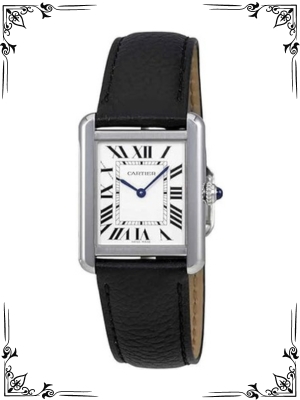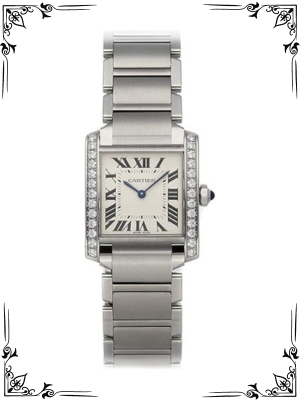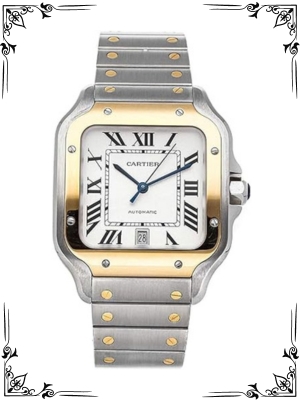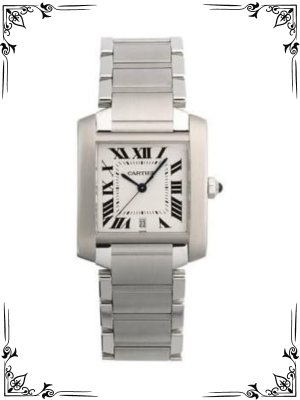Cartier Tank Louis prioritizes luxury with precious metals and high-end movements, making it a statement piece for collectors. The Tank Must offers a more accessible version with stainless steel or vermeil, ideal for everyday wear with its modern take on the classic Tank design.
Introduction
The Cartier Tank collection represents a pinnacle of watchmaking elegance and historical significance. Within this esteemed lineup, two models reign supreme: the Cartier Tank Louis and the Cartier Tank Must.
Both embody the essence of Cartier’s Art Deco heritage, yet cater to distinct preferences. This comprehensive guide delves into the intricacies of the Tank Louis and Tank Must, comparing their design, materials, movements, and target audiences.
A Legacy Forged in Steel: Unveiling the Cartier Tank Louis
A Timeless Design
The Tank Louis was born in 1919, inspired by the silhouette of the Renault FT-17 tank. Its rectangular case with tapered brancards (strap attachments) and a Roman numeral dial became an instant classic. The design remained virtually unchanged throughout its history, a testament to its enduring appeal.
Material and Craftsmanship
The Tank Louis is traditionally crafted from precious metals like platinum, 18k yellow gold, or rose gold. This commitment to premium materials underscores the watch’s luxurious nature. Each Tank Louis is meticulously assembled and finished by hand, showcasing Cartier’s exceptional craftsmanship.
Movement
Traditionally, the Tank Louis housed high-quality Swiss-made mechanical movements, either manually wound or automatic. Today, some models might utilize high-precision Cartier manufacturing movements, further elevating their exclusivity.
A Statement Piece
The Tank Louis, with its precious metal construction and classic design, is a statement piece. It exudes an air of sophistication and prestige, making it ideal for formal occasions and discerning collectors.
The Approachable Icon: Unveiling the Cartier Tank Must
A Modern Interpretation
Introduced in 1977, the Tank Must offered a more accessible alternative to the Tank Louis. It retained the core design elements but opted for stainless steel or vermeil (sterling silver plated with gold) construction. The dial often featured simpler indexes instead of Roman numerals, offering a more contemporary aesthetic.
Material and Affordability
The Tank Must prioritize affordability by utilizing stainless steel or vermeil. This allows a wider audience to experience the iconic Tank design without the hefty price tag of precious metals.
Movement
The Tank Must traditionally house reliable quartz movements or automatic ETA-based mechanical movements. Today, some models might utilize quartz or automatic Cartier manufacturing movements.
Everyday Elegance
The Tank Must, with its more accessible materials and streamlined design, is perfect for everyday wear. It offers a touch of luxury without being overly ostentatious, making it suitable for various occasions.
| Feature | Cartier Tank Louis | Cartier Tank Must |
|---|---|---|
| Design | Classic, rectangular with tapered brancards | Modern interpretation of the Tank Louis design |
| Material | Precious metals (platinum, 18k gold) | Stainless steel, vermeil |
| Movement | High-quality Swiss mechanical (manual or automatic), Cartier Manufacture (some models) | Quartz, automatic ETA (traditional), Cartier Manufacture (some models) |
| Price Point | Higher | More affordable |
| Target Audience | Discerning collectors, formal occasions | Everyday wear, wider audience |
Choosing the Right Cartier Tank
Selecting between Tank Louis and Tank Must boils down to your priorities:
- For a timeless statement piece crafted from precious metals, the Tank Louis epitomizes luxury and heritage.
- For a more affordable and versatile option perfect for everyday wear, the Tank Must offers a contemporary interpretation of the iconic Tank design.
Remember, these are just general guidelines. Explore both models in person to discover which one resonates most with your style and preferences.
Exploring Variations within Each Model
Tank Louis Variations:
- Tank Louis Cartier: The original and most classic version.
- Tank Louis XL: A larger version of the Tank Louis for those who prefer a bolder presence.
- Tank Louis Skeleton: A high-end variation featuring a skeletonized dial revealing the intricate movement within.
Tank Must Variations:
- Tank Must de Cartier: The original version with a streamlined design.
- Tank Must SolarBeat™: Eco-friendly option with a solar-powered quartz movement.
- Tank Must Large: A bigger version of the Tank Must for those seeking a more prominent wrist presence.
The Evolution of the Cartier Tank
The Cartier Tank collection transcends mere timekeeping. It’s a testament to enduring design, adapting to the times while retaining its core essence. This iconic silhouette has graced wrists for over a century, witnessing historical shifts and evolving with subtle grace. Here’s a glimpse into the remarkable journey of the Cartier Tank:
Birth of a Legend (1919)
The year 1919 marked the birth of the Tank. Inspired by the silhouette of the Renault FT-17 tank, Louis Cartier envisioned a watch that captured the spirit of the modern era. The rectangular case with tapered brancards and a clean, uncluttered dial embodied a revolutionary aesthetic. This watch, christened the “Tank Louis Cartier,” became an instant sensation.
Enduring Elegance (1920s-1930s)
The roaring twenties and thirties witnessed the Tank solidify its status as a design icon. The Tank Cintrée, with its curved case, offered a feminine variation, while the Tank à Guichets (Tank with windows) incorporated complications like a moon phase or date display.
Despite these variations, the core design principles remained remarkably consistent, a testament to the Tank’s inherent elegance.
World War II and Beyond (the 1940s-1950s)
World War II presented challenges for the production of luxury goods like the Tank. However, the post-war era ushered in a renewed focus on style and refinement. New Tank variations emerged, like the Tank Américaine with a wider case and the Tank Chinoise with a unique square case.
These variations further solidified the Tank’s versatility and ability to adapt to changing trends.
A Modern Interpretation (1960s-1970s)
The 1960s and 70s saw a shift towards a more minimalist aesthetic. The introduction of the Tank Must in 1977 offered a more affordable and contemporary interpretation of the Tank design. By utilizing stainless steel and vermeil instead of precious metals, the Tank Must broadened the Tank’s reach to a wider audience, attracting a new generation of watch enthusiasts.
Quartz Revolution and Beyond (1980s-Present)
The quartz revolution of the 1980s impacted the watch industry. The Tank embraced this innovation, offering quartz versions alongside its traditional mechanical movements.
Today, the Tank collection continues to evolve, incorporating advancements like solar-powered quartz movements (Tank Must SolarBeat™) and in-house Cartier manufacturing movements in both the Tank Louis and Tank Must. Despite these advancements, the core design language of the Tank remains remarkably consistent, a testament to its timeless appeal.
The Future of the Tank
The Cartier Tank’s story is far from over. As technology and preferences continue to evolve, one can expect the Tank to adapt while retaining its core identity. Whether it’s through the introduction of new materials, innovative complications, or even connected features, the Tank will undoubtedly continue to grace wrists and define elegance for generations to come.
Design Details
While both models share the iconic Tank silhouette, some subtle design differences exist:
Case Shape: The Tank Louis features a slightly square case compared to the Tank Must’s ever-so-slightly rounded case.
Brancards: The Tank Louis’ brancards are typically more prominent and tapered, while the Tank Must’s brancards might be slightly slimmer.
Crown: The Tank Louis traditionally features a blue sapphire cabochon on the crown, while the Tank Must utilizes a synthetic spinel cabochon in a similar teardrop shape.
Dial: The Tank Louis often boasts classic Roman numerals, while the Tank Must might feature simpler indexes or even Roman numerals with a more contemporary font.
These seemingly minor distinctions contribute to the overall character of each watch. The Tank Louis exudes a more traditional and luxurious vibe, while the Tank Must offers a modern and streamlined aesthetic.
Exploring Movement Options
The movement within a watch dictates its functionality and value. Let’s delve deeper into the movement options for each model:
Tank Louis:
Traditional: Historically, the Tank Louis housed high-quality Swiss-made mechanical movements, either manually wound or automatic. These movements offered superior craftsmanship and a connection to watchmaking tradition.
Modern: Today, some Tank Louis models might utilize Cartier Manufacture movements. These in-house movements represent the pinnacle of Cartier’s watchmaking expertise, often featuring exceptional finishing and potentially higher complications.
Tank Must:
Traditional: The Tank Must traditionally house reliable quartz movements or automatic ETA-based mechanical movements. Quartz movements offered superior accuracy and convenience, while ETA movements provided a cost-effective option with proven reliability.
Modern: Some modern Tank Must models might utilize Cartier Manufacture movements, either quartz or automatic. These movements offer the same benefits as their counterparts in the Tank Louis but within a more accessible price range.
Choosing the Right Movement
The choice between a mechanical and quartz movement depends on your preferences:
Mechanical movements: Offer a connection to watchmaking tradition, superior craftsmanship (especially in high-end options), and the satisfaction of manual winding or automatic operation. However, they require more maintenance and might be less accurate than quartz movements.
Quartz movements: Provide exceptional accuracy, require minimal maintenance, and offer convenience. However, they lack the “soul” of a mechanical movement.
Ultimately, the movement choice depends on your priorities and budget.
Investment Potential
Cartier watches particularly the Tank Louis, are considered luxury goods with a strong brand heritage. These factors can influence their value retention:
Tank Louis: Due to its use of precious metals, high-quality movements, and limited production numbers (especially vintage models), the Tank Louis has the potential for greater value retention over time. It can be viewed as a potential investment piece for collectors.
Tank Must: While still a desirable timepiece, the Tank Must’s use of more affordable materials and potentially larger production numbers might result in less dramatic value appreciation over time. However, it remains a valuable addition to any watch collection.
Remember, value retention depends on various factors, including model, condition, and market fluctuations. Invest in a watch primarily for your enjoyment, and any potential value appreciation is a bonus.
FAQs
Which Cartier Tank is more popular?
Both models are incredibly popular. The Tank Louis might hold a slight edge amongst collectors and those seeking a statement piece, while the Tank Must’s affordability and versatility attract a wider audience.
Is the Cartier Tank Louis worth the price?
The value proposition depends on your priorities. If you prioritize precious metals, high-quality movements, and a timeless design, the Tank Louis might be worth the investment. If affordability and everyday wearability are your focus, the Tank Must offers excellent value.
Can I wear a Cartier Tank with a casual outfit?
While the Tank Louis traditionally leans towards formality, the larger Tank Louis XL or a Tank Must with a simple dial can work well with some casual attire.
Where can I buy a Cartier Tank?
Cartier boutiques and authorized retailers are the safest options for purchasing a genuine Cartier Tank. Exercise caution when buying pre-owned models online.
What are some alternatives to the Cartier Tank Louis and Tank Must?
Several brands offer watches inspired by the Tank design at more accessible price points. However, the rich heritage and craftsmanship of Cartier remain unmatched.
Conclusion
The Cartier Tank Louis and Tank Must represent two sides of the same coin. Both embody the timeless elegance of the Tank design, catering to distinct preferences.
For the discerning collector who values tradition, precious metals, and the prestige of a statement piece, the Tank Louis stands as a true icon.
For those seeking a more accessible and versatile interpretation of the Tank design, the Tank Must offers a luxurious touch for everyday wear.
Ultimately, the perfect Cartier Tank is the one that resonates most with your personal style and aspirations. Visit a Cartier boutique or authorized retailer to experience these exquisite timepieces firsthand. Try them on, appreciate the intricate details, and consider which one best complements your individuality.
With its rich legacy and enduring design, a Cartier Tank is not just a watch; it’s an investment in timeless elegance and a connection to a legendary brand.





